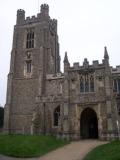A
very short history of Newport
 |
| Newport
from Debden Road |
The earliest certain mention of the name Newport for this village
appears in
the Domesday Book of 1086, although there is evidence of human
habitation going
back possibly to the paleolithic period. The name means a new town;
‘port’ was
often a name for a market in Saxon times, and Newport did have a
flourishing
market. The village grew and prospered until around AD1300, after which
it
declined and its market ceased; it was overtaken in importance by its
near
neighbour, Saffron Walden.
Until the 20th century Newport was mostly dependent upon agriculture,
although
a wide variety of occupations have been followed in the past, notably
in the
leather trade and in woolcombing and later, in malting.
 |
 |
| Crown
House |
Monks
Barn |
It is likely that the first church here was built in the late Saxon
period, but
the present church (well worth a visit) was built in the first half of
the 13th
century. There are many attractive old buildings - the oldest apart
from the
church dates from the late 14th century. Perhaps the two most
interesting are
The Crown House (mostly late 16th century), with its 17th century
pargetting,
and Monks Barn, a Wealden type house dating from the 15th century and
featuring
an oriel window supported by a carved wooden bracket.
In 1588 Newport Free Grammar School was founded by Dame Joyce
Frankland;
although it has retained its name it began to take boys of all
abilities in
1976, and is now fully comprehensive and also co-educational.
Until comparatively recently the village had six large mixed farms. The
Enclosure Acts of the 18th century had no effect here; Newport was
covered by
the 1856 Enclosure Act and it was not until 1861 that the last of the
open
fields were enclosed and medieval strip farming finally came to an end.
Newport used to contain a very large royal fish pond and hence was
known as
Newport Pond, but the pond had dried up by the 16th century and that
name has
fallen into disuse. King Charles II probably drove through the village
on his
way to Newmarket and we know that Samuel Pepys visited a house here,
although,
tantalisingly, we do not know which one. On the creation of a turnpike
trust in
1744 the road was greatly improved. This brought new people and new
trade to
the village, as did the arrival of the railway in 1845.
Until the
second World War, Newport was heavily
influenced by the great estates of Shortgrove Hall and Quendon Hall
each of which
had substantial land and property holdings in the Village. These
provided substantial
employment for
farm labourers, gamekeepers etc and in the case of Shortgrove for
gardeners,
carpenters and both male and female house staff. However, the decline
of the estates, the
effect of agricultural revolution and the sale of much of the farms and
other
properties has almost entirely removed their influence.
The greatest
changes have occurred recently. 100
years ago about 900 people, largely agricultural workers, lived in some
220
dwellings. By 1971 the population had increased somewhat to over 1,200.
Since
then all the livestock farms have closed, fields, orchards and farm
premises in
the centre of the village have been built over, and more than 2,200
people now
occupy over 900 houses. Today, scarcely any Newportonians are engaged
in
agriculture; instead our occupations cover a diversity of industries,
mostly
outside the village, many commuting to Cambridge or London. Newport is
fortunate to
have retained it’s
Station, Post Office, Village Stores, Plant Nursery & Florist,
Men &
Ladies Hairdressers, a number of retail and service businesses and
enjoys a
substantial Medical Centre.
Newport has a lively community with activities for all, ranging from
Scouting to
Local History. These
are identified in Newport
News, our twice-yearly village magazine. This is the
principal medium for
publication of local history research in the locality. including A Village in
Time: the history of Newport,
Essex.






